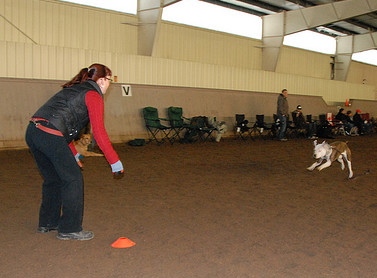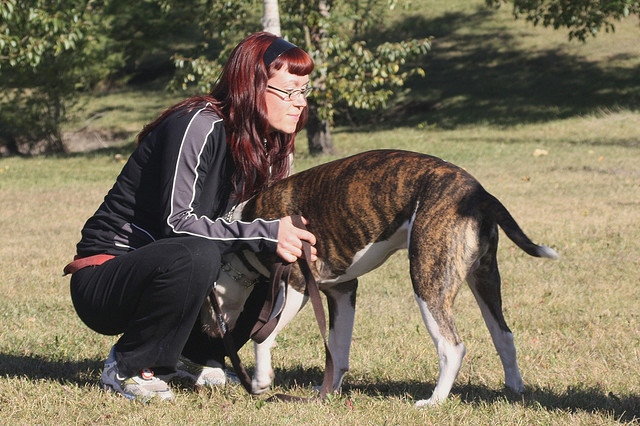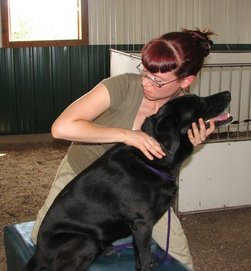How To Recognize If Your Animal Will Benefit From Chiropractic Care

Excerpt and adapted from the IVCA website
“Qualified chiropractors are trained to recognize and treat musculoskeletal problems. However riders, trainers, and owners can monitor whether or not their animals are moving as well as they could. Dog handlers, trainers or owners can look for signs of dysfunction in their pets. Inspecting the spine before purchasing is just as important as inspecting the legs.”
**Please note, the best type of healthcare, regardless of profession, is PREVENTION NOT TREATMENT. Having your animals checked by a Certified Animal Chiropractor before they develop problems is always the best choice. Dr. Wuest believes in striving for optimal health, not just absence of disease or dysfunction. Of course, she will always respect your right to make all healthcare decisions related to your animal.
The following symptoms in a HORSE
may indicate dysfunction of the neuromusculoskeletal system:
Behaviour
- Reduced performance
- Abnormal posture
- Snapping and pinning back its ears when being saddled
- Insubordination when being ridden
- The attempt to free itself by throwing its head back or up or by hollowing the back
- Swishing its tail and pinning back its ears
- Disobedience when jumping
- Difficulties with collected or lateral gaits
- Changes in behavior
- Frightened or painful facial expression
- Sensitivity to touch
Joint restrictions in the spine can affect muscle coordination and mobility of the horse, thereby causing decreased performance. The following symptoms may occur:
- Unleveled gait rhythm
- Irregularity of gait which cannot be assigned to a particular leg or gait
- Stiffness when the horse leaves the stable
- Stiffness when bending and in its general posture
- Muscular atrophy
- Brushing or interfering
- Difficulty engaging the hindquarters
- Difficulty working “long and low”
- Shortened stride in one or more legs
- Overall decreased range of motion in gait
- Difficulty flexing the poll
- Lameness
- Horse pulls against one rein
- Rider is seated off centre due to the horse
- The back does not swing
Your own observations in your horse
Consider your horse’s recent performance and demeanor:
- Has your horse’s behavior or performance changed recently? – e.g. refusing fences, not taking leads properly, having more difficulty turning to one side, etc.
- Does unusual or fluctuating lameness exist?
- Does the rider have difficulty sitting straight on the horse?
- Has the rider or trainer noticed changes in the various gaits?
- Does the horse drag its feet or are the shoes worn down on one side
Examining mobility in your horse
- The horse should be able to move freely in all directions without tension, with or without a rider.
- Using a treat if necessary, ask the horse to turn its head and neck to the side so that it touches its flank with its nostrils. Less mobility on one side compared to the other could indicate a problem in the cervical vertebrae.
- Test the lateral movement of the spine by placing one hand on the spine and with the other pull the horse’s tail carefully towards you so that its back bends around your hand.
- Is one side stiffer than the other?
- Place slight pressure on the back from above. The back should easily and evenly, spring and swing. It should not feel stiff and hard.

The following symptoms in a DOG may indicate
dysfunction in the musculoskeletal system:
Behaviour
- Reluctance to move
- Abnormal posture
- Disability to climb stairs or jump onto raised areas
- Limited performance
- Signs of pain during certain movements or being lifted
- The animal only lies on one side
- Disobedience when jumping
- Altered sitting position (so-called “puppy sitting”)
- Changes in behavior
- Frightened or painful facial expression
- Sensitivity to touch
Joint restrictions in the spine can affect muscle coordination and mobility of the dog, thereby causing decreased performance. The following symptoms may occur:
- Unleveled gait rhythm
- Irregularity of gait which cannot be assigned to a particular leg or gait
- Stiffness after sleeping
- Stiffness when bending and in general posture
- Muscular atrophy
- Lick granuloma
- Sciatica neuralgia
- Undefined lameness. This can be caused by joint restrictions in the joints of limbs or the spine.
- Shortened stride in one or more legs
- Overall decreased range of motion in gait
- Recurrent anal gland infections
- Recurrent ear infections
- Incontinence. This can be exacerbated by joint restrictions in the lumbar vertebrae.
- Hypersensitivity and hyposensitivity
- The back does not swing
Your own observations in your dog
Consider your dog´s recent performance and demeanor:
- Has your dog’s behavior or performance changed recently? – e.g. less interested in play, reluctance to do activities, etc.
- Does unusual or fluctuating lameness exist?
- Is the dog reluctant to move?
- Has the handler or trainer noticed changes in motivation of the dog?
- Does the dog drag its feet or are the nails worn down on one side?
Examining mobility in your dog
The dog should be able to move freely in all directions without tension.
- Using a treat if necessary, ask the dog to turn its head and neck to the side so that it touches its flank with its nostrils. Less mobility one side compared to the other could indicate a problem in the cervical vertebrae.
- Test the lateral movement of the spine by placing one hand on the spine and with the other pull the dog’s tail carefully towards you so that its back bends around your hand.
- Is one side stiffer than the other?
- Place slight pressure on the back from above. The back should easily and evenly, spring and swing. It should not feel stiff and hard.


Feeling The Muscles
Examine the animal´s main muscle groups for pain, tension and asymmetry. The muscles of a healthy animal should be symmetrical; feeling firmly elastic but not too hard or too soft. If you place the muscles under moderate pressure, the animal should not show signs of being in pain.
Feeling The Spine
Feel the spine from the withers to the tail, paying attention to any elevations and protruding areas of bone. Compare the two sacral tubercles (the bony points of the pelvis which protrude from the croup on both sides of the spine) these should be level. Look for any protruding areas of bone in the neck.
Neurological Effects
A major effect of spinal joint restrictions can be impairment to the flow of information in the nerves which exit the spinal cord between the vertebrae. As these nerves innervate the skin, certain glands and blood vessels, such neurological disturbance can lead to the following symptoms:
- Unusual itching at the base of the tail or other parts of the body
- Increased sensitivity to heat and cold
- Asymmetrical or reduced perspiration
This list of symptoms is certainly not exhaustive however, it does demonstrate the wide variety of symptoms an animal chiropractor is trained to recognized and treat.
